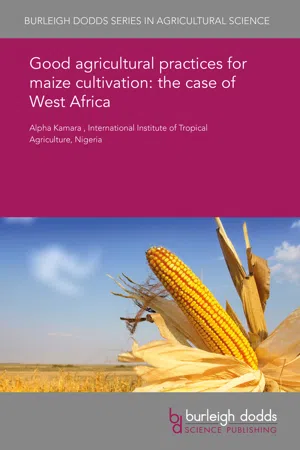
Good agricultural practices for maize cultivation: the case of West Africa
- English
- PDF
- Available on iOS & Android
Good agricultural practices for maize cultivation: the case of West Africa
About this book
Maize is the most important staple food crop for over 300 million people in sub-Saharan Africa but poor management practices and problems related to climate and soil quality mean that yields regularly fall below what is needed to feed the population. This chapter describes the effect of poor soil fertility, drought and weeds (especially Striga hermonthica) on maize yields. It then puts forward evidence-based strategies for mitigating these constraints, including nutrient management through the use of fertilizers on maize yields and approaches to weed management such as genetic engineering of tolerant and resistant maize varieties. Finally, the chapter examines ways of dealing with the challenge of drought, including improved irrigation and genetic engineering of drought-resistant maize varieties.
Frequently asked questions
- Essential is ideal for learners and professionals who enjoy exploring a wide range of subjects. Access the Essential Library with 800,000+ trusted titles and best-sellers across business, personal growth, and the humanities. Includes unlimited reading time and Standard Read Aloud voice.
- Complete: Perfect for advanced learners and researchers needing full, unrestricted access. Unlock 1.4M+ books across hundreds of subjects, including academic and specialized titles. The Complete Plan also includes advanced features like Premium Read Aloud and Research Assistant.
Please note we cannot support devices running on iOS 13 and Android 7 or earlier. Learn more about using the app.
Information
Table of contents
- 1 Introduction
- 2 Poor soil fertility and effects of drought on maize in West Africa
- 3 Weed competition with maize
- 4 Maize nutrient management
- 5 Weed management for maize cultivation
- 6 Management of soil moisture stress in maize
- 7 Future trends and conclusion
- 8 Where to look for further information
- 9 References